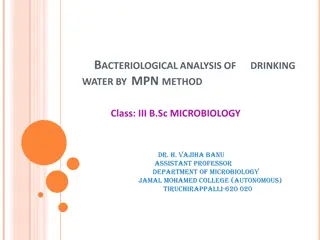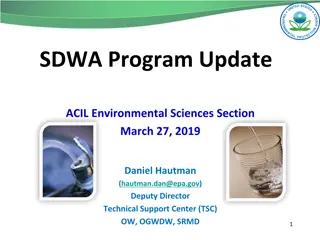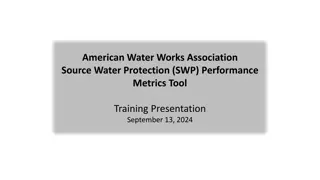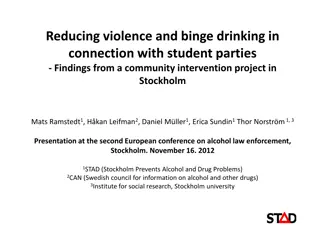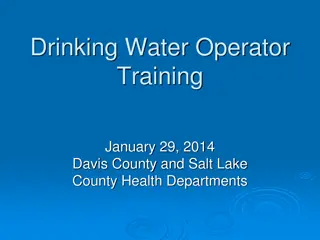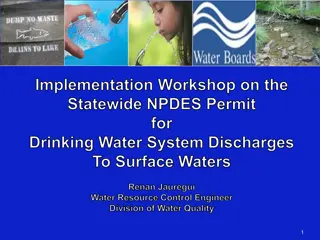Managing Fluoride Levels in Drinking Water
Defluoridation is the process of adjusting fluoride levels in drinking water to the optimal range to prevent health issues such as fluorosis. The recommended fluoride level in drinking water is 1 ppm according to WHO guidelines. Various techniques like locating alternative water sources, defluoridation, and preventive measures are employed to ensure safe drinking water. Economic, efficient, and consistent defluoridation methods are essential for community health and water quality.
Download Presentation

Please find below an Image/Link to download the presentation.
The content on the website is provided AS IS for your information and personal use only. It may not be sold, licensed, or shared on other websites without obtaining consent from the author.If you encounter any issues during the download, it is possible that the publisher has removed the file from their server.
You are allowed to download the files provided on this website for personal or commercial use, subject to the condition that they are used lawfully. All files are the property of their respective owners.
The content on the website is provided AS IS for your information and personal use only. It may not be sold, licensed, or shared on other websites without obtaining consent from the author.
E N D
Presentation Transcript
Defluoridation of level Defluoridation is is defined of level level . . defined as, fluoride in as, the drinking water the downward water to downward adjustment to the adjustment the optimal level of of fluoride in drinking optimal
The recommended optimum level of fluoride in drinking water is 1 ppm (WHO 1963). 1 The recommended optimum level of fluoride in drinking water is ppm Optimum level of fluoride that can be consumed by normal adult is 1 mg/day. ` ` The maximum allowable level of fluoride in drinking water According to WHO = 1- 1.5 ppm According to BIS = 0.6-1.2 ppm (the less the better) According to ICMR = 1PPM (WHO 1963). Optimum level of fluoride that can be consumed by normal adult is 1 mg/day. The maximum allowable level of fluoride in drinking water. 4
The 1984 climate the optimal fluoride concentration in drinking water should remain below 1 mg/l (1ppm or part per million), while in cooler climates it could go up to 1.2 mg/l. 1984 WHO WHO guidelines guidelines suggested that in areas with a warm Piddennavar International Piddennavar Renuka, International Journal Renuka, Krishnappa Journal Of Krishnappa Pushpanjali Of Engineering Pushpanjali. . Review And Science Review on 2013; ;2 2( (3 3) ): :86 on Defluoridation 86- -94 Defluoridation Techniques 94. . Techniques of of Water Water. .The The Engineering And Science 2013 5
Locating alternative sources of safe water. Bringing in water from a distant, safe source. Removal of fluoride from water (defluoridation), using suitable techniques. Prevention of industrial fluorosis. Rain water harvesting. Constructing check dams, which raise the ground water level and decrease ground water F- concentration by dilution. Blending high fluoride with low fluoride water. Dual water sources. 6
Economic Efficient Consistency Simple plant Raw Acceptable Should Should Economic Efficient Consistency in Simple technique, plant Raw materials Acceptable to Should not Should not in performance technique, where performance over where unskilled over a a prolonged unskilled personnel prolonged period personnel can period can operate operate the the materials should to the not impart not change should be the community impart bad change pH be readily community bad taste pH of readily available available taste and of water and odor water odor to to the the treated treated water water 7
Adsorption technique Ion-exchange technique Precipitation technique Other techniques 8
Adsorption Adsorption Ion- -exchange Anion exchange resins: - -NCL poly anion resin, -Tulsion A27, -Lewatit-MIH-59, -Amberlite IRA- 400, - Deacedite FF-IP, -Waso resin-14, -Polystyrene. Ion exchange Precipitation -Lime, -Alum, -Lime & Alum (Nalgonda technique), - Alum flock blanket method, -Poly Aluminium Chloride (PAC), -Poly Aluminium -Hydroxy Sulphate (PAHS), -Brushite Precipitation Others Others -Carbon materials, - Activated Alumina, - Magnesia, -Tricalcium phosphate, -Calcite, -Hydroxy apatite, - Wood, -Lignite, -Activated char coal, -Bone char, -Processed bone, -Nut shells, -Avaram bark, Paddy husk, -Tea waste, -Jute waste, -Coir pitch, -Fly ash, -Bauxite, -Serpentine Anion exchange resins: - Electrochemical method (Aluminium electrode), -Electro dialysis, -Electrolysis, -Reverse Osmosis Cation resins: Defluoron-1, Defluoron-2, Carbion Cation exchange resins: exchange 9
This technique functions on the adsorption of fluoride ions onto the surface of an active agent. Activated alumina, activated carbon and bone char were among the highly tested adsorbing agents. 10
1. Activated Alumina 1. Activated Alumina Application of domestic defluoridation plants based on activated alumina has been launched by UNICEF in rural India -- famously known as Prasanthi Prasanthi technique technique . . The F removing efficiency of activated alumina gets affected by hardness and surface loading. The ph is maintained between 5 and 6 11
This process can remove fluoride up to 90% Effective and economical It requires minimum contact time for maximum defluoridation It is indigenously available and cheap Percentage of regeneration is considerably high.
Disadvantages : Disadvantages : Adsorption of fluoride is possible only at specific pH range, needing pre-and post- pH adjustment of water. Frequent activation of Alumina is needed, which make the technique expensive. Generates concentrated fluoride solution, causing disposal problems. Disposal of fluoride laden sludge is also a problem Skilled personnel are required for plant operation 13
2. Activated Carbon 2. Activated Carbon Among various treatments used, activated carbon is a powerful adsorbent due to large large surface surface area area and and pore pore volume volume. . It can be prepared from the different raw materials, such as wood, lignite, coal, bone, petroleum residues, nutshells other low cost/waste materials like the rice coconut shell, tree bark, cotton waste etc. wood, lignite, coal, bone, petroleum residues, nutshells and also from rice- -husk, saw dust, husk, saw dust, coconut shell, tree bark, cotton waste etc. 14
It is a highly economic technique with 62 - 66% defluoridation. The optimum time for the adsorption to reach saturation is 9 hours and optimum pH of fluoride solution is between 7 - 7.5. 15
The efficacy of the plant depends upon temperature and pH of raw water; duration of contact. The efficiency can be improved by pre-treating the raw water with Brushite Brushite and Calcium hydroxide Calcium hydroxide. 16
The bone char is unhygienic (harbors bacteria). Regular fluoride analysis to check whether the material is exhausted. It is a technique sensitive procedure, charring procedure should be done cautiously. Cultural and religious objections . 17
BRICK Principle Principle: : same as that of activated alumina. The soil used for brick manufacturing contains Aluminium oxide. During burning operation in the kiln, it gets activated. Replacement of filter media is required once in 3 months if fluoride content in raw water is 2.5 mg/l. The cost of the filter unit is about Rs 600 /-. 18
Can not achieve complete defluoridation. All the soils are not rich in Aluminium oxide. Possibility of microbial contamination of brick. 19
Mud pot Mud pot Economical and readily acceptable for the rural communities. Disadvantages It results a marginal reduction in water fluoride level from 1.8 ppm to 1.5 and 1.4 ppm at the end of 2 days and 4 days respectively, which is practically not significant. Disadvantages: : The water pH was raised from 7.7 to 8.11 and 8.14 the end of 2 days and 4 days respectively, which is beyond the acceptable limits of alkalinity. 20
Seeds of the Drumsticks Roots of Vetiver Tamarind seeds Mangosteen fruits Rooster feathers Seeds of the Drumsticks Vetiver grass Roots of grass Tamarind seeds Mangosteen fruits Rooster feathers 21
DEFLUORIDATION BY ION DEFLUORIDATION BY ION- -EXCHANGE EXCHANGE Synthetic chemicals, namely, anion and cation exchange resins have been used for fluoride removal. Used in chloride and hydroxy form. These are commercially produced resins which are expensive in most circumstances. Carbion : : a) Carbion a) It is a Cation exchange resin of good durability and can be used both on sodium and hydrogen cycle. 22
De A sulphonated saw dust impregnated with 2% alum solution Drawbacks : the medium had poor hydraulic properties - cost De Fluoron Fluoron 1: 1964 1: 1964 Defluoran Developed in 1968. It is sulphonated coal & works on the aluminum cycles. Defluoran- -2: 2: Life of medium is 2- 4 yrs The average fluoride removal capacity of the medium is 484mg F/L 23
Advantages Removes fluoride up to 90-95% It helps in the retention of taste and colour of water intact. Advantages
Disadvantages: Waste produced is very large Expensive. Regeneration of resin is a problem because it leads to fluoride rich waste, which has to be treated separately before final disposal Treated water has a very low pH and high levels of chloride The regeneration and maintenance of plant required skilled operation & personnel which may not be readily available. 25
Major drawbacks of techniques are: Major drawbacks of Ion techniques are: Ion- -exchange exchange and and adsorption adsorption 1.The necessary flow through system is often difficult to arrange where there is no piped water supply 2.Gradual exhaustion of the active agent is not easily detected. 26
Reverse osmosis, electrolysis and electro dialysis are physical methods that are tested for defluoridation of water. Though they are effective in removing fluoride salts from water, there are certain disadvantages that limit their usage on a large scale.
In reverse osmosis, the hydraulic pressure is exerted on one side of the semi permeable membrane which forces the water across the membrane leaving the salts behind. In electro dialysis, the membranes allow the ions to pass but not the water. The driving force is an electric current which carries the ions through the membranes.
The process is highly effective for fluoride removal It permits the treatment and disinfection of water in one step It ensures constant water quality No chemicals are required and very little maintenance is needed Life of membrane is sufficiently long, so problem of regeneration or replacement is encountered less frequently It works under wide pH range No interference by other ions is observed The process works in a simple, reliable automated operating regime with minimal manpower using compact modular model.
It removes all the ions present in water. Since though some minerals are essential for proper growth therefore, remineralisation is required after treatment The process is expensive in comparison to other options The water becomes acidic and needs pH correction Lots of water gets wasted as brine Disposal of brine is a problem
Addition of chemicals (coagulants and coagulant aids) and the subsequent precipitation of a sparingly soluble fluoride salt as insoluble fluorapatite. The best example for this technique is Nalgonda technique 31
Nalgonda Nalgonda technique technique National Environment Engineering Research Institute (NEERI), Nagpur (1974 ) Nalgonda Technique involves addition of Aluminium lime Aluminium salts, salts, lime and bleaching bleaching powder powder. . Economical and simple method. This technique is extremely useful for both domestic as well as for community water supply. 32
Aluminium water and may be added as Aluminium Sulphate or Aluminium Chloride or Combination. Aluminium salt salt responsible for removal of fluoride from The dose of Aluminium salt increases with increase in the fluoride and alkalinity levels of the raw water. 33
The dose of lime of Aluminium salt. lime is empirically 1/20th that of the dose Lime maintains alkalinity of the solution and facilitates formation of dense flocks for rapid settling. Bleaching of 3 mg/l for disinfection. Bleaching powder powder is added to the raw water at the rate 34
1. 2. 3. 4. 5. 1. Rapid Mixing 2. Flocculation 3. Sedimentation 4. Filtration 5. Disinfection and Distribution Rapid Mixing Flocculation Sedimentation Filtration Disinfection and Distribution 35
1 1) )Rapid Rapid mixing is an operation by which the coagulant is rapidly and uniformly dispersed through out a single or multiple phase system. Rapid Mixing Mixing: : Duration= 30-60 sec Speed=10-20 rpm 36
2 2) ) Flocculation Flocculation: : Settable particles : polymeric formed. polymeric aluminium aluminium hydroxides hydroxides (flock) Achieved by gentle and prolonged mixing for 10-15 mins at 2-4 rpm. Besides, bacteria, turbidity, colour, odour, pesticides and organics are also removed. 37
3 3) ) Sedimentation Sedimentation: : It is separation from the water by gravitational setting of suspended particles that are heavier than water. Factors that affect sedimentation are: 1. size , shape , density and nature of particles. 2. Viscosity , density and temperature of water 3. Surface over flow rate 4. Velocity of flow 38
4 4) ) Filtration Filtration: : Rapid gravity sand filters are suggested to receive coagulated and settled water. In these filters unsettled gelatinous flock is retained. Residual fluorides and bacteria are absorbed on the gelatinous flock retained on the filter bed. The flocculated water is allowed to settle and filter through fullers earth candle overnight. 5 5) ) Disinfection Disinfection and and Distribution Distribution: : The filtered water collected in the storage water tank is chlorinated with bleaching powder before distribution. 39
No regeneration of media No handling of caustic acids and alkalis. Readily available chemicals. Adaptable to domestic use. Highly efficient. Effective even when dissolved solids are 1500mg/l and hardness >600 mg/l Simplicity of design, construction, operation and maintenance. No energy except muscle power for domestic equipment. Can be adopted by the common man. 40
Simultaneous removal of colour, odour, turbidity, bacteria and organic contaminants. Sludge generated is convertible to alum for use elsewhere. Little wastage of water and least disposal problems. minimum equipment. Can be used as both fill-and-draw and continuous operation community level. Needs of mechanical and electrical system and both at domestic and Low investment and maintenance costs. 41
Generation of higher quantity of sludge compared to electrochemical defluoridation. The large amount of alum needed to remove fluoride. Careful pH control of treated water is required. High residual aluminium is reported. 42
Poly concentrations of fluoride, the removal efficiency of fluoride is higher with PAC when compared with Alum. Poly Aluminium less flocculation time and setting time. Poly Aluminium Aluminium chloride chloride: : it is evident that for higher Poly Aluminium Hydroxy Hydroxy Sulphate Sulphate: : is found to require 43







